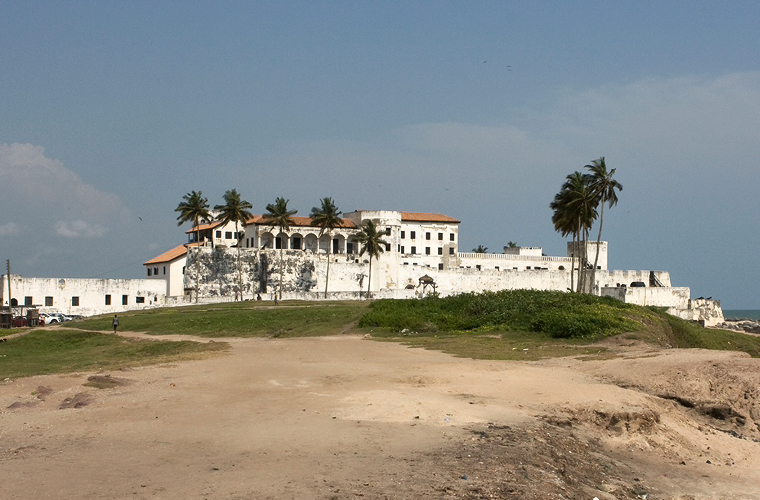Built in 1482 by Portuguese traders, Elmina Castle was the first European slave-trading post in all of sub-Saharan Africa. Located on the western coast of present-day Ghana, it was originally built to protect the gold trade but following its capture by the Dutch in 1637, it came to serve the Dutch slave trade with Brazil and the Caribbean. The castle came under British ownership in the 1800s.
Elmina, like other West African slave fortresses, housed luxury suites for the Europeans on the upper levels. The slave dungeons below were cramped and filthy, each cell often housing as many as 200 people at a time, without enough space to even lie down. The floor of the dungeon, as a result of centuries of impacted filth and human excrement, is now several inches higher than it was when it was built. Outbreaks of malaria and yellow fever were common. Staircases led directly from the governor’s chambers to the women’s dungeons below, making it easy for him to select personal concubines from amongst the women.
At the seaboard side of the castle was the Door of No Return, the infamous portal through which slaves boarded the ships that would take them on the treacherous journey across the Atlantic known as the Middle Passage. By the 18th century, 30,000 slaves on their way to North and South America passed through Elmina’s Door of No Return each year.
Today, Elmina’s economy is sustained by tourism and fishing. Elmina Castle is preserved as a Ghanaian national museum and monument and is designated as a World Heritage Monument under UNESCO. It offers daily historical tours and is an extremely popular destination for African American tourists seeking to connect with their heritage.




















Although it was originally erected to protect the gold trade, following its capture by the Dutch in 1637, Elmina Castle came to serve the Dutch slave trade with Brazil and the Caribbean. The castle later developed as a point on the infamous slave triangle transporting human cargo to America and the Caribbean, as well as raw materials, such as cotton and rubber, to Britain, and manufactured goods, such as clothing and weaponry, back to the West Coast of Africa.
Under the auspices of the Dutch West Indies Company, around 30,000 slaves a year passed through Elmina until 1814 when the Dutch slave trade was abolished. Ceded to the British in 1872, Elmina Castle was rarely in use until Ghana’s independence from Britain in 1957. Thereafter, it became a training center for Ghanaian police recruits and even a school for a short while, before being converted into a historical museum.
The days of the slave trade may be long gone, but the interior of the castle is still a haunting reminder of the past. Not knowing what awaited them on the slave ships, those who made it to Elmina Castle were held captives in the castle’s dungeons and subjected to all kinds of indignities, torture, and humiliation. The dark, airless dungeons in the basements were oppressive and received sunlight from only two tiny windows.
Slave traders would cram more than 1,000 slaves, with no water or sanitation, into a space that could barely fit around 200 people. These dungeons were uncomfortably cramped and filthy, and outbreaks of malaria and yellow fever were common. Food was scarce and disease was rampant. Prisoners sometimes had to spend up to three months in such unsanitary conditions before they were shipped to the New World. At the seaboard side of the castle is the infamous ‘Door of No Return’, which was a portal where slaves boarded ships that would take them on the treacherous journey across the Atlantic known as the Middle Passage.
Revolts by slaves at Elmina were met with strong oppression. Some captives were either murdered outright, while others were placed in solitary confinement in an airtight, dark holding facility in the courtyard where they were starved to death. Thousands of slaves, both men and women were chained outside and forced to stand in the blazing sun. They could be made to lift heavy cannonballs as punishment and women were often raped by the guards.
Elmina Castle, like other West African slave sites, also housed luxury suites for Europeans on the upper levels of the castle. Upstairs, the officers’ quarters were light and spacious with parquet floors and gorgeous sea views. It is difficult to imagine how they could live such a life of comfort while thousands languished beneath their feet.
Despite its atrocities, the castle also once served as a missionary sanctuary and housed a church.

